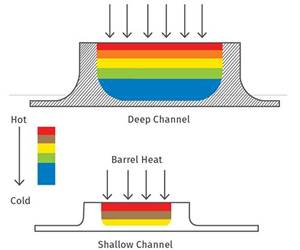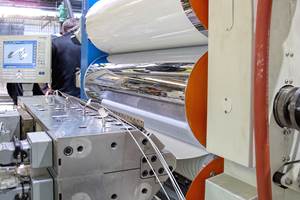Don't Get Burned by Adapters & Flow Pipes
Does degraded or burned polymer seem to show up when you least expect it?
Does degraded or burned polymer seem to show up when you least expect it? If so, it’s probably coming from one of your adapters or coextrusion flow pipes. While only very badly designed screws and dies will cause polymer to degrade during processing, the same cannot be said of adapters and flow pipes. Complicating matters is a design “catch 22” concerning these components. Typically they are designed to minimize pressure drop, yet minimum velocities must be maintained inside the flow channels to continuously clean the walls. These two design considerations are contradictory because the larger the channel, the lower the pressure drop—and the lower the velocity.
Every polymer will have its own velocity profile shape in the channel, depending on its melt characteristics. All are parabolic in general shape, but some are rather blunt while others are pointed. As the channel gets larger, or as the flow rate is reduced, the major portion of the flow becomes more centered in the channel while the polymer near the walls moves slower.
There is always a static layer of polymer adhering to the flow-channel wall, but it’s necessary to maximize the flow adjacent that layer to help its gradual renewal. As the flow rate drops, there is a corresponding increase in the portion of the polymer that is moving very slowly or even stops. In close proximity to the continuously heated surface of the adapter or flow pipe, the slow-moving polymer is subjected to a very long heat history and slowly degrades, eventually turning to a carbon-like material. The degraded polymer loses its flow properties and a completely static layer builds on the channel inner wall. This layer becomes brittle and extrusion pressure occasionally breaks off bits that pass along with the melt. These tend to come out all at once or in “showers.” This happens most often when the output is increased or some other process change occurs.
If such issues occur, it is not necessarily due to an error by the machinery designer. More likely it’s because the equipment was designed for a much higher output than is currently being run, resulting in lower than anticipated flow velocity. As with many polymer flow issues, this can be investigated by calculating the shear stress at the wall. Data required are a shear rate/viscosity plot at the melt temperature and the dimensions of the flow channel. This can be a relatively easy calculation when using Newtonian formulas and the actual viscosity data. Minimum shear-stress levels required to maintain clean channel walls have been determined pretty much by trial and error but generally are quite consistent.
Operators often try to correct the problem of buildup of degraded polymer by lowering the temperature of the adapters or flow pipes. Generally this makes matters worse as it increases the initial static layer thickness, and even though the temperature is lower it is still more than enough to eventually degrade the polymer. The only complete solution is to match the flow channel diameter to the output so as to keep the channel as nearly full as possible while controlling pressure drop. Sometimes to control pressure drop will require shortening the flow channels, necessitating changing the position of some equipment. This same situation applies to any portion of the polymer flow channels from the exit of the extruder to the exit of the die.
About the Author
Jim Frankland is a mechanical engineer who has been involved in all types of extrusion processing for more than 40 years. He is now president of Frankland Plastics Consulting, LLC. Contact jim.frankland@comcast.net or (724)651-9196.
Related Content
Choosing the Right Gearbox and Motor for Your Single-Screw Extruder
Extruder OEMs are typically very good at sizing motors and gear boxes for extrusion applications. But you have the final decision on the acceptance of the design. Here’s what you should consider.
Read MoreHow Polymer Melts in Single-Screw Extruders
Understanding how polymer melts in a single-screw extruder could help you optimize your screw design to eliminate defect-causing solid polymer fragments.
Read MoreThe Importance of Barrel Heat and Melt Temperature
Barrel temperature may impact melting in the case of very small extruders running very slowly. Otherwise, melting is mainly the result of shear heating of the polymer.
Read MoreRoll Cooling: Understand the Three Heat-Transfer Processes
Designing cooling rolls is complex, tedious and requires a lot of inputs. Getting it wrong may have a dramatic impact on productivity.
Read MoreRead Next
Lead the Conversation, Change the Conversation
Coverage of single-use plastics can be both misleading and demoralizing. Here are 10 tips for changing the perception of the plastics industry at your company and in your community.
Read MoreSee Recyclers Close the Loop on Trade Show Production Scrap at NPE2024
A collaboration between show organizer PLASTICS, recycler CPR and size reduction experts WEIMA and Conair recovered and recycled all production scrap at NPE2024.
Read MorePeople 4.0 – How to Get Buy-In from Your Staff for Industry 4.0 Systems
Implementing a production monitoring system as the foundation of a ‘smart factory’ is about integrating people with new technology as much as it is about integrating machines and computers. Here are tips from a company that has gone through the process.
Read More.jpg;width=70;height=70;mode=crop)












